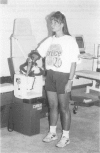Abstract
Objective:
We review the application of isokinetic testing and training for the shoulder complex, the interpretation of isokinetic testing data, and the application of normative data in the rehabilitation and performance enhancement of the athlete.
Data Sources:
We searched MEDLINE for the years 1989- 1999 using the key words “isokinetics,” “shoulder,” and “upper extremity.”
Data Synthesis:
Isokinetic testing and training is an integral part of the comprehensive evaluation and treatment of the shoulder complex. This mode of exercise allows for objective, isolated joint testing and training.
Conclusions/Recommendations:
Isokinetic training and testing is an important part of the comprehensive evaluation and rehabilitation of the patient with a shoulder injury. Research has demonstrated its efficacy in training and in providing clinically relevant information regarding muscular performance. When integrated with a complete history, subjective examination, and physical and functional evaluation, isokinetic exercise can be a valuable tool for the clinician in the assessment, rehabilitation, and performance enhancement of the athlete.
Keywords: glenohumeral joint, isokinetic exercise, muscle function
Full text
PDF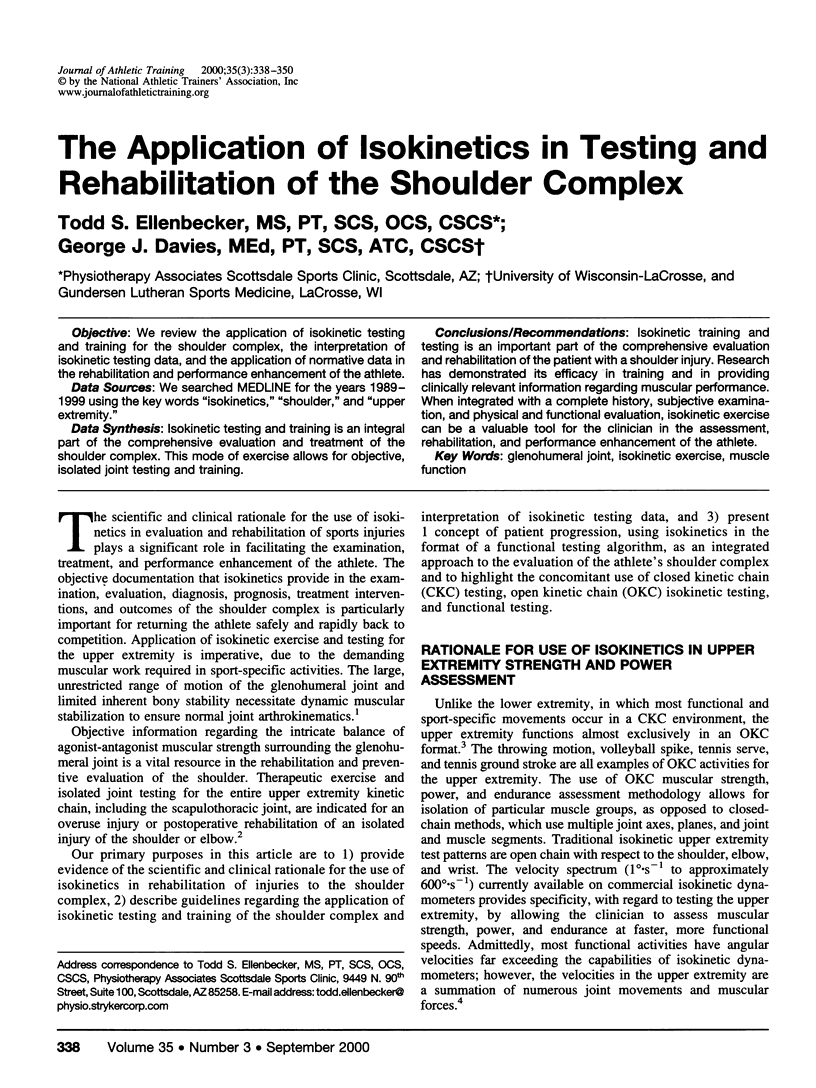
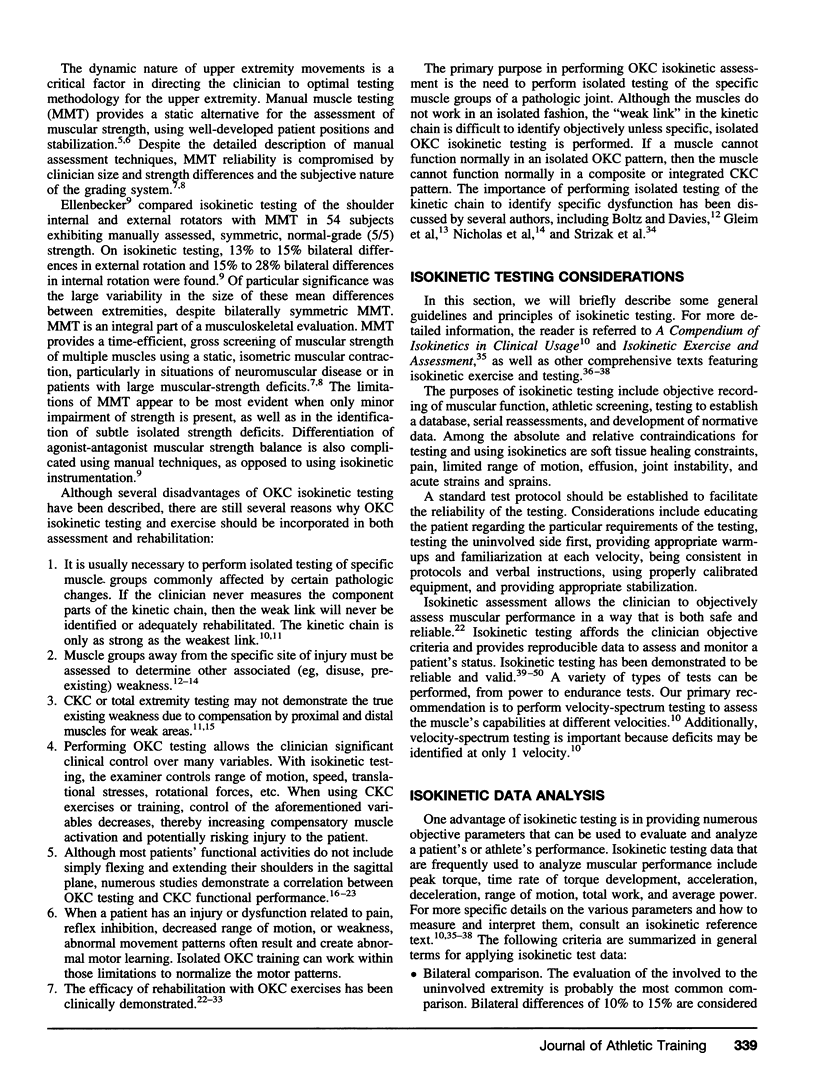
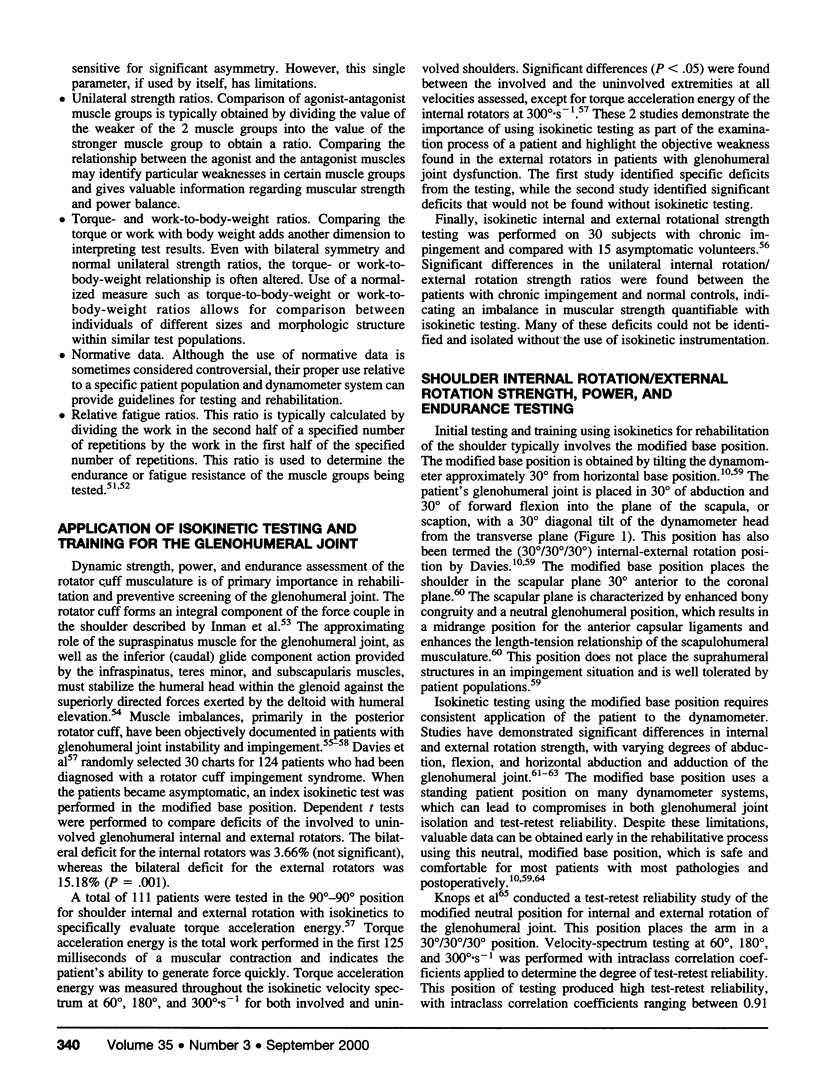
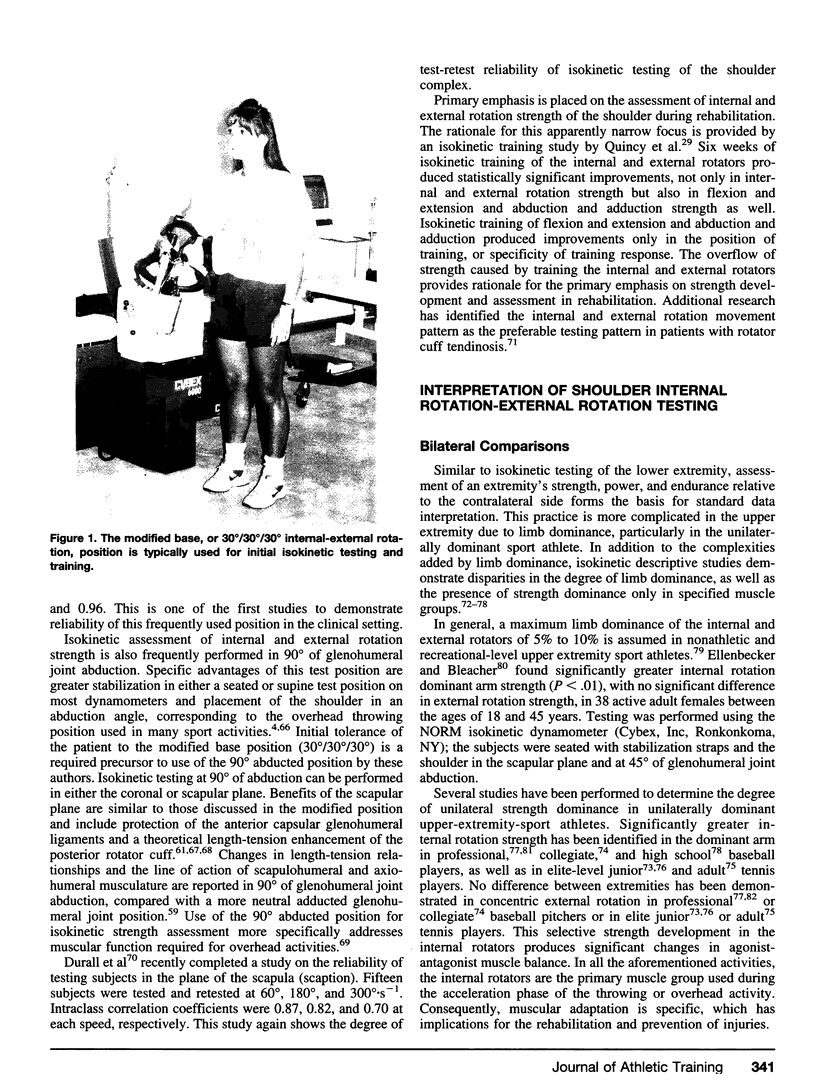
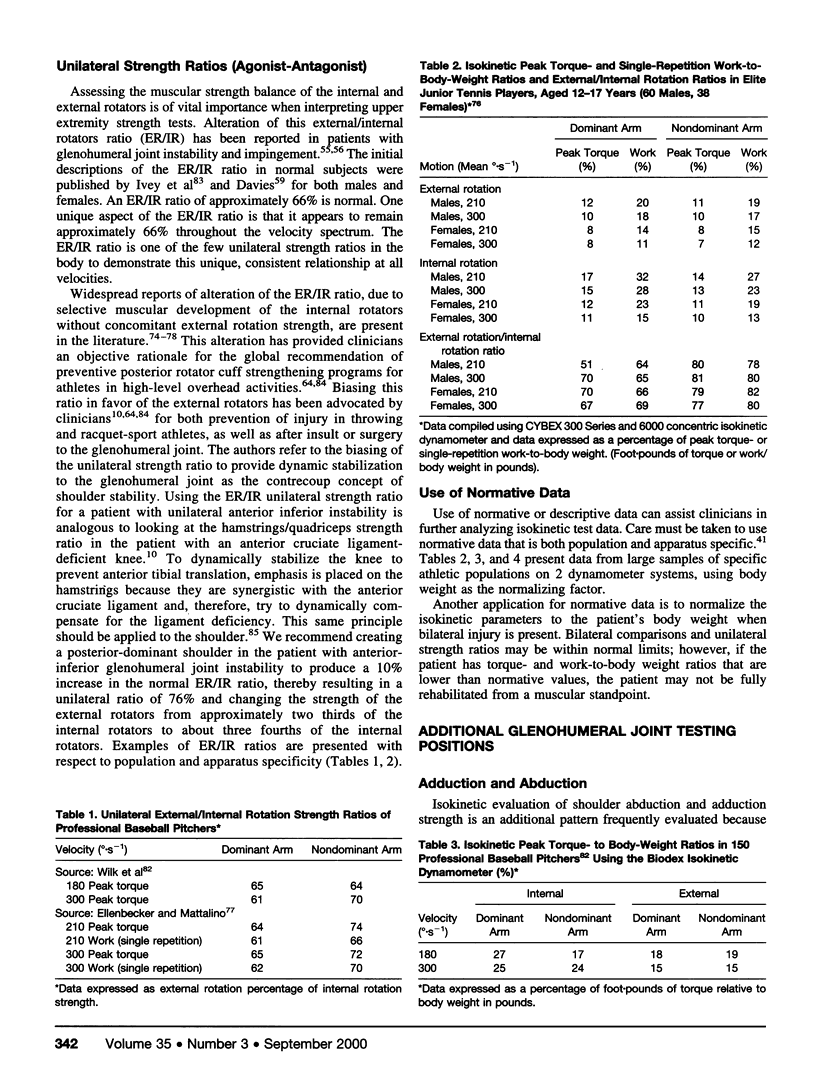
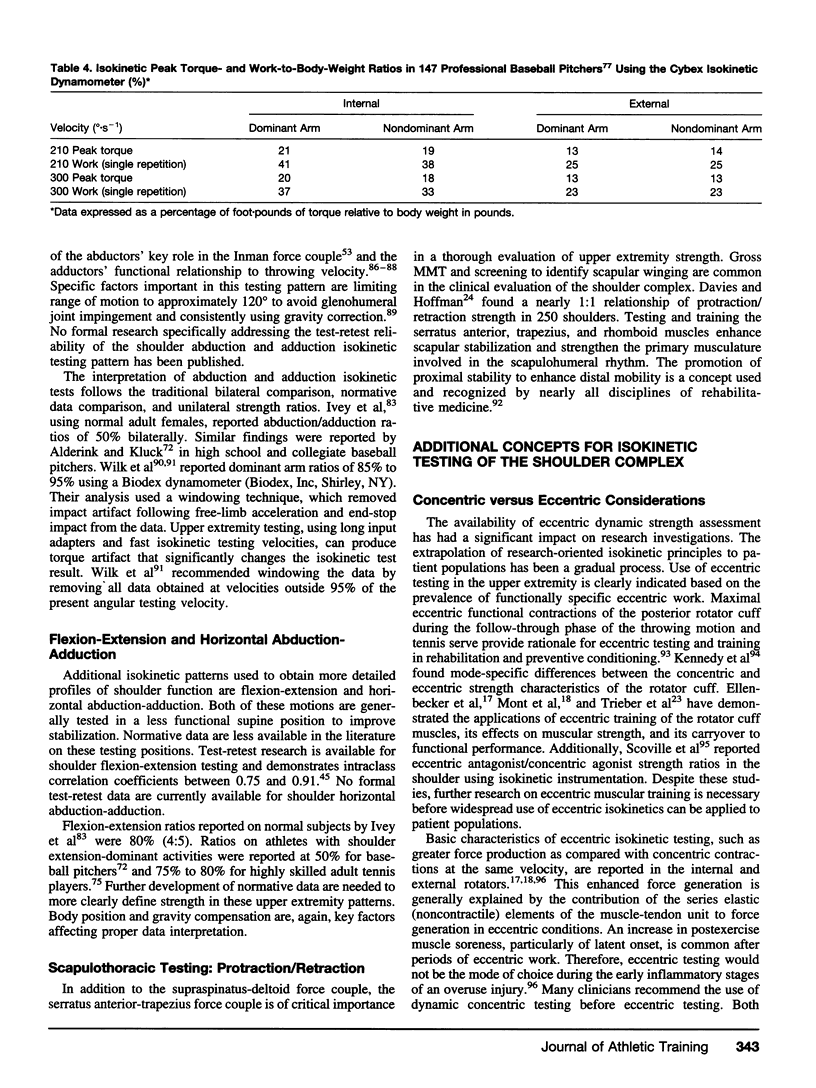
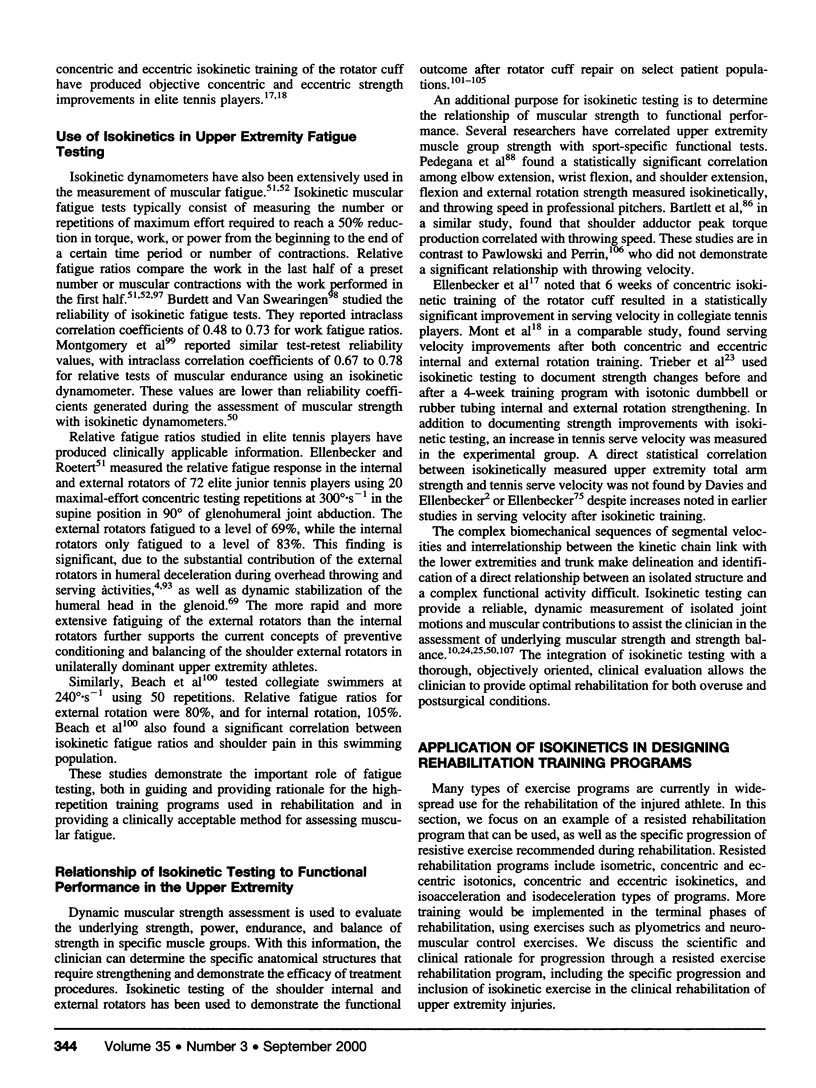
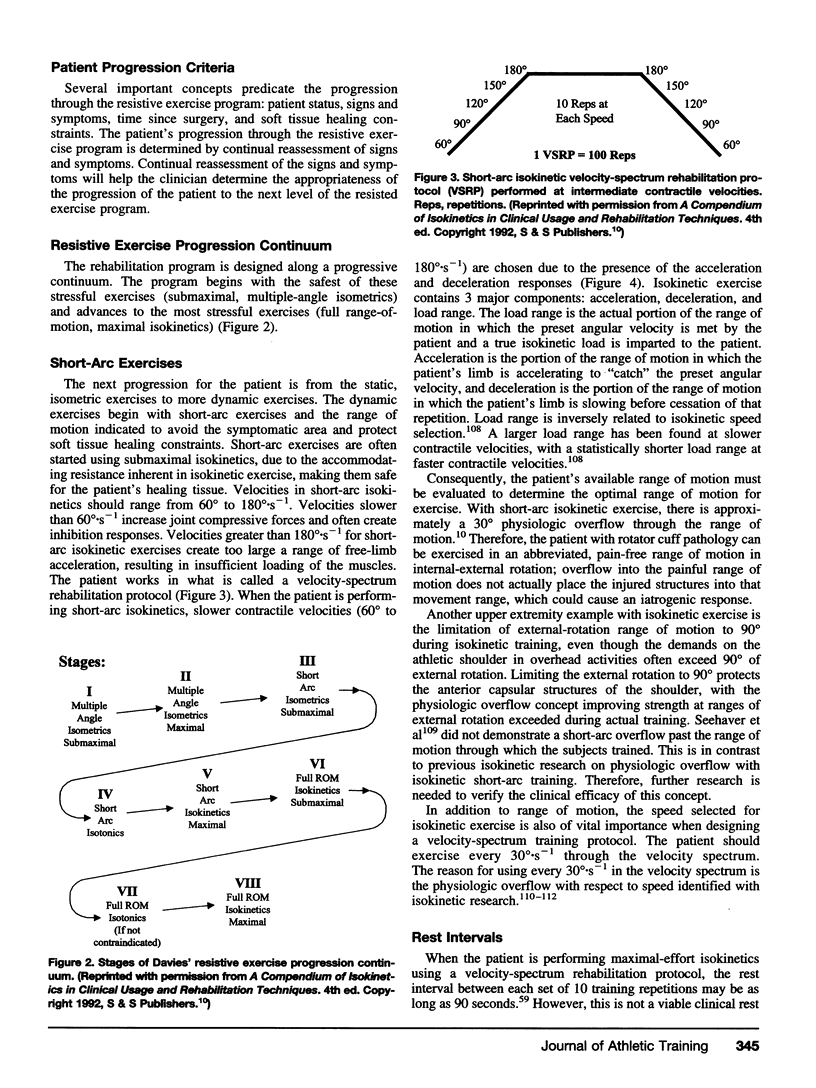

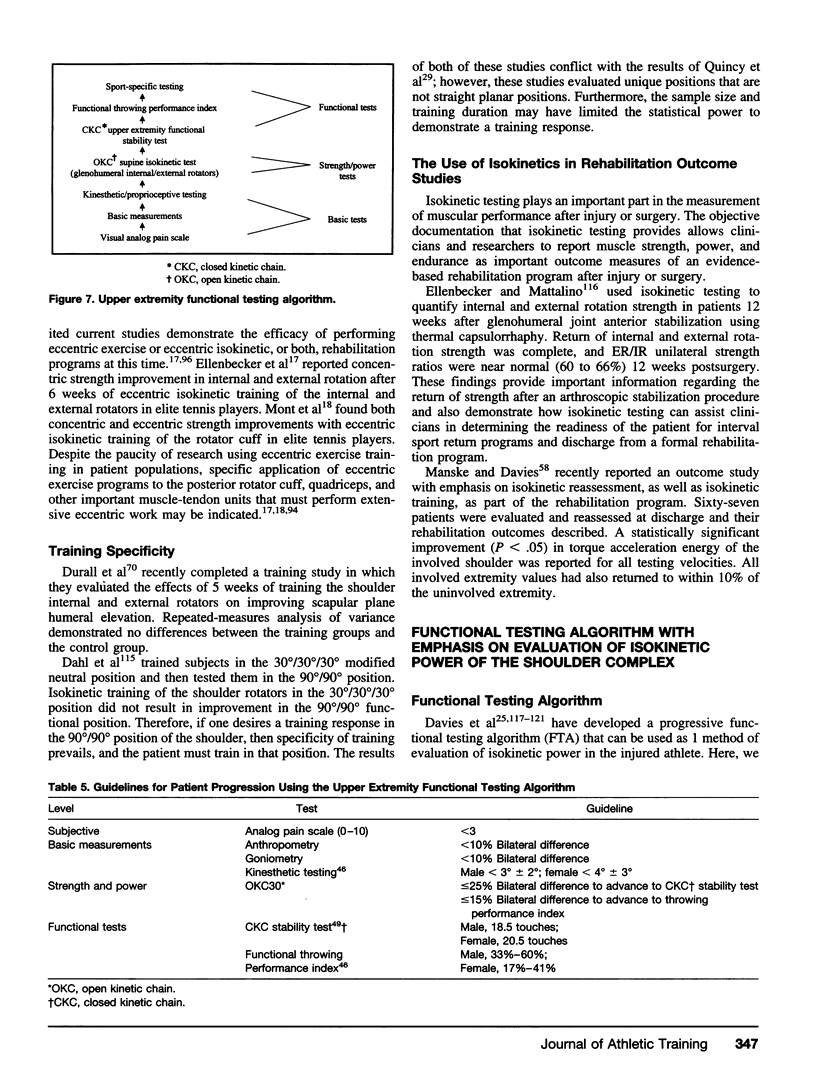
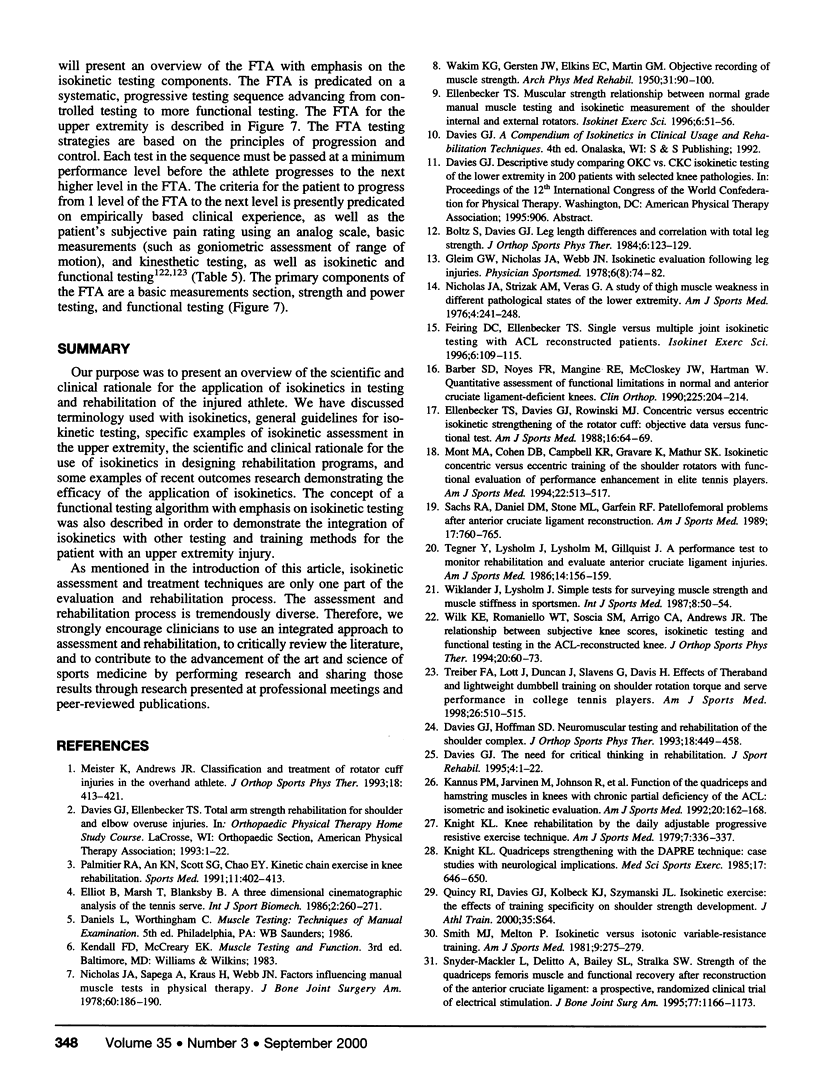
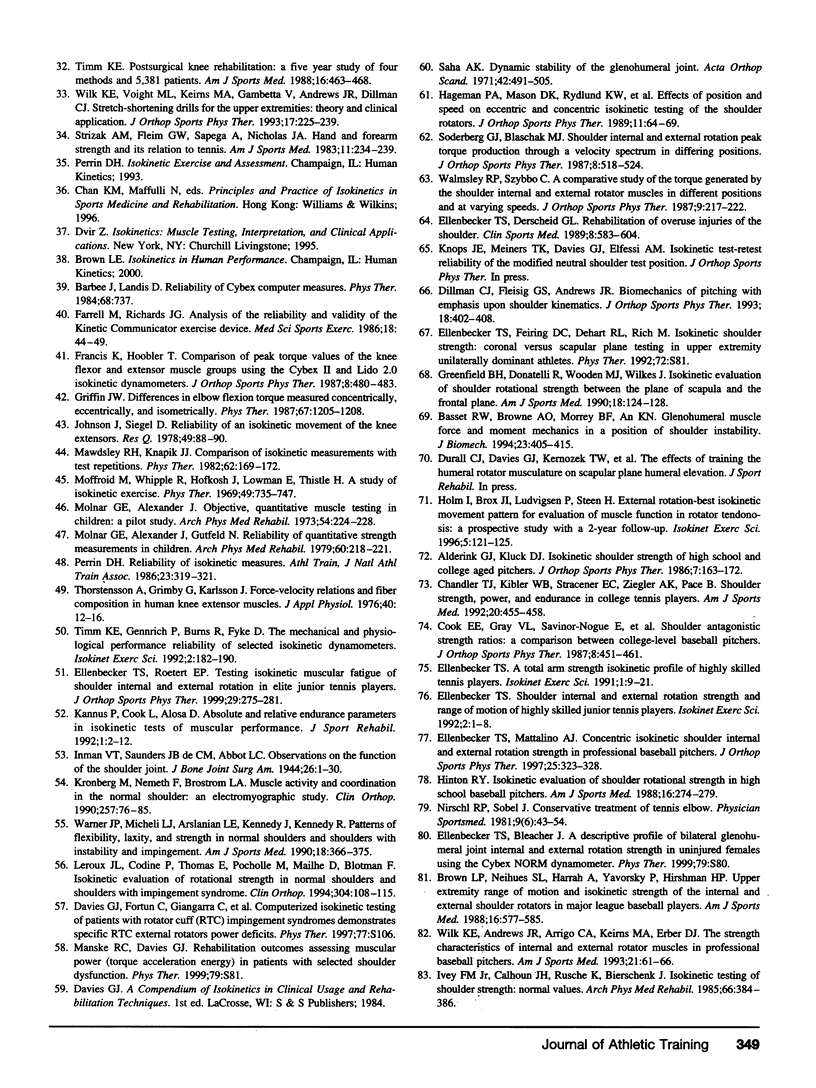
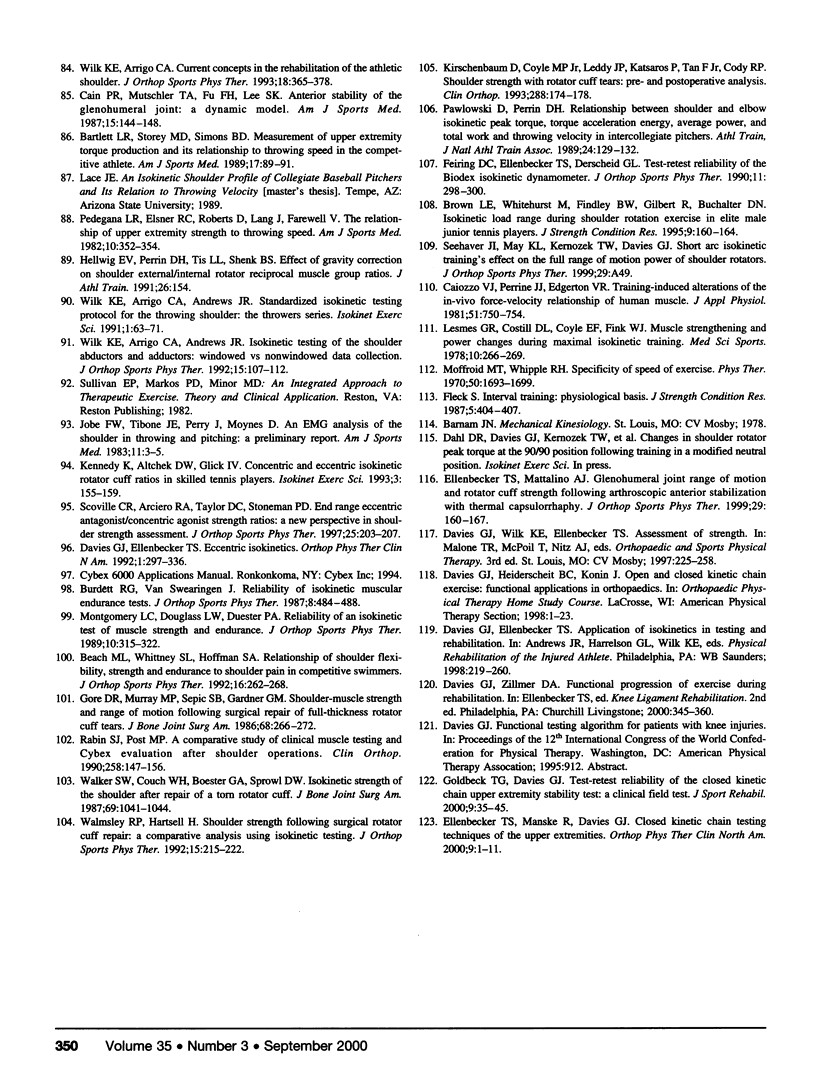
Images in this article
Selected References
These references are in PubMed. This may not be the complete list of references from this article.
- Barber S. D., Noyes F. R., Mangine R. E., McCloskey J. W., Hartman W. Quantitative assessment of functional limitations in normal and anterior cruciate ligament-deficient knees. Clin Orthop Relat Res. 1990 Jun;(255):204–214. [PubMed] [Google Scholar]
- Bartlett L. R., Storey M. D., Simons B. D. Measurement of upper extremity torque production and its relationship to throwing speed in the competitive athlete. Am J Sports Med. 1989 Jan-Feb;17(1):89–91. doi: 10.1177/036354658901700115. [DOI] [PubMed] [Google Scholar]
- Bassett R. W., Browne A. O., Morrey B. F., An K. N. Glenohumeral muscle force and moment mechanics in a position of shoulder instability. J Biomech. 1990;23(5):405–415. doi: 10.1016/0021-9290(90)90295-e. [DOI] [PubMed] [Google Scholar]
- Brown L. P., Niehues S. L., Harrah A., Yavorsky P., Hirshman H. P. Upper extremity range of motion and isokinetic strength of the internal and external shoulder rotators in major league baseball players. Am J Sports Med. 1988 Nov-Dec;16(6):577–585. doi: 10.1177/036354658801600604. [DOI] [PubMed] [Google Scholar]
- Cain P. R., Mutschler T. A., Fu F. H., Lee S. K. Anterior stability of the glenohumeral joint. A dynamic model. Am J Sports Med. 1987 Mar-Apr;15(2):144–148. doi: 10.1177/036354658701500209. [DOI] [PubMed] [Google Scholar]
- Caiozzo V. J., Perrine J. J., Edgerton V. R. Training-induced alterations of the in vivo force-velocity relationship of human muscle. J Appl Physiol Respir Environ Exerc Physiol. 1981 Sep;51(3):750–754. doi: 10.1152/jappl.1981.51.3.750. [DOI] [PubMed] [Google Scholar]
- Chandler T. J., Kibler W. B., Stracener E. C., Ziegler A. K., Pace B. Shoulder strength, power, and endurance in college tennis players. Am J Sports Med. 1992 Jul-Aug;20(4):455–458. doi: 10.1177/036354659202000416. [DOI] [PubMed] [Google Scholar]
- Davies G. J., Dickoff-Hoffman S. Neuromuscular testing and rehabilitation of the shoulder complex. J Orthop Sports Phys Ther. 1993 Aug;18(2):449–458. doi: 10.2519/jospt.1993.18.2.449. [DOI] [PubMed] [Google Scholar]
- Dillman C. J., Fleisig G. S., Andrews J. R. Biomechanics of pitching with emphasis upon shoulder kinematics. J Orthop Sports Phys Ther. 1993 Aug;18(2):402–408. doi: 10.2519/jospt.1993.18.2.402. [DOI] [PubMed] [Google Scholar]
- Ellenbecker T. S., Davies G. J., Rowinski M. J. Concentric versus eccentric isokinetic strengthening of the rotator cuff. Objective data versus functional test. Am J Sports Med. 1988 Jan-Feb;16(1):64–69. doi: 10.1177/036354658801600112. [DOI] [PubMed] [Google Scholar]
- Ellenbecker T. S., Derscheid G. L. Rehabilitation of overuse injuries of the shoulder. Clin Sports Med. 1989 Jul;8(3):583–604. [PubMed] [Google Scholar]
- Ellenbecker T. S., Mattalino A. J. Concentric isokinetic shoulder internal and external rotation strength in professional baseball pitchers. J Orthop Sports Phys Ther. 1997 May;25(5):323–328. doi: 10.2519/jospt.1997.25.5.323. [DOI] [PubMed] [Google Scholar]
- Ellenbecker T. S., Mattalino A. J. Glenohumeral joint range of motion and rotator cuff strength following arthroscopic anterior stabilization with thermal capsulorraphy. J Orthop Sports Phys Ther. 1999 Mar;29(3):160–167. doi: 10.2519/jospt.1999.29.3.160. [DOI] [PubMed] [Google Scholar]
- Ellenbecker T. S., Roetert E. P. Testing isokinetic muscular fatigue of shoulder internal and external rotation in elite junior tennis players. J Orthop Sports Phys Ther. 1999 May;29(5):275–281. doi: 10.2519/jospt.1999.29.5.275. [DOI] [PubMed] [Google Scholar]
- Farrell M., Richards J. G. Analysis of the reliability and validity of the kinetic communicator exercise device. Med Sci Sports Exerc. 1986 Feb;18(1):44–49. [PubMed] [Google Scholar]
- Gore D. R., Murray M. P., Sepic S. B., Gardner G. M. Shoulder-muscle strength and range of motion following surgical repair of full-thickness rotator-cuff tears. J Bone Joint Surg Am. 1986 Feb;68(2):266–272. [PubMed] [Google Scholar]
- Greenfield B. H., Donatelli R., Wooden M. J., Wilkes J. Isokinetic evaluation of shoulder rotational strength between the plane of scapula and the frontal plane. Am J Sports Med. 1990 Mar-Apr;18(2):124–128. doi: 10.1177/036354659001800202. [DOI] [PubMed] [Google Scholar]
- Griffin J. W. Differences in elbow flexion torque measured concentrically, eccentrically, and isometrically. Phys Ther. 1987 Aug;67(8):1205–1208. doi: 10.1093/ptj/67.8.1205. [DOI] [PubMed] [Google Scholar]
- Hinton R. Y. Isokinetic evaluation of shoulder rotational strength in high school baseball pitchers. Am J Sports Med. 1988 May-Jun;16(3):274–279. doi: 10.1177/036354658801600314. [DOI] [PubMed] [Google Scholar]
- Ivey F. M., Jr, Calhoun J. H., Rusche K., Bierschenk J. Isokinetic testing of shoulder strength: normal values. Arch Phys Med Rehabil. 1985 Jun;66(6):384–386. [PubMed] [Google Scholar]
- Jobe F. W., Tibone J. E., Perry J., Moynes D. An EMG analysis of the shoulder in throwing and pitching. A preliminary report. Am J Sports Med. 1983 Jan-Feb;11(1):3–5. doi: 10.1177/036354658301100102. [DOI] [PubMed] [Google Scholar]
- Johnson J., Siegel D. Reliability of an isokinetic movement of the knee extensors. Res Q. 1978 Mar;49(1):88–90. [PubMed] [Google Scholar]
- Kannus P., Järvinen M., Johnson R., Renström P., Pope M., Beynnon B., Nichols C., Kaplan M. Function of the quadriceps and hamstrings muscles in knees with chronic partial deficiency of the anterior cruciate ligament. Isometric and isokinetic evaluation. Am J Sports Med. 1992 Mar-Apr;20(2):162–168. doi: 10.1177/036354659202000212. [DOI] [PubMed] [Google Scholar]
- Kirschenbaum D., Coyle M. P., Jr, Leddy J. P., Katsaros P., Tan F., Jr, Cody R. P. Shoulder strength with rotator cuff tears. Pre- and postoperative analysis. Clin Orthop Relat Res. 1993 Mar;(288):174–178. [PubMed] [Google Scholar]
- Knight K. L. Knee rehabilitation by the daily adjustable progressive resistive exercise technique. Am J Sports Med. 1979 Nov-Dec;7(6):336–337. doi: 10.1177/036354657900700605. [DOI] [PubMed] [Google Scholar]
- Knight K. L. Quadriceps strengthening with the DAPRE technique: case studies with neurological implications. Med Sci Sports Exerc. 1985 Dec;17(6):646–650. doi: 10.1249/00005768-198512000-00004. [DOI] [PubMed] [Google Scholar]
- Kronberg M., Németh G., Broström L. A. Muscle activity and coordination in the normal shoulder. An electromyographic study. Clin Orthop Relat Res. 1990 Aug;(257):76–85. [PubMed] [Google Scholar]
- Leroux J. L., Codine P., Thomas E., Pocholle M., Mailhe D., Blotman F. Isokinetic evaluation of rotational strength in normal shoulders and shoulders with impingement syndrome. Clin Orthop Relat Res. 1994 Jul;(304):108–115. [PubMed] [Google Scholar]
- Lesmes G. R., Costill D. L., Coyle E. F., Fink W. J. Muscle strength and power changes during maximal isokinetic training. Med Sci Sports. 1978 Winter;10(4):266–269. [PubMed] [Google Scholar]
- Mawdsley R. H., Knapik J. J. Comparison of isokinetic measurements with test repetitions. Phys Ther. 1982 Feb;62(2):169–172. doi: 10.1093/ptj/62.2.169. [DOI] [PubMed] [Google Scholar]
- Meister K., Andrews J. R. Classification and treatment of rotator cuff injuries in the overhand athlete. J Orthop Sports Phys Ther. 1993 Aug;18(2):413–421. doi: 10.2519/jospt.1993.18.2.413. [DOI] [PubMed] [Google Scholar]
- Moffroid M., Whipple R., Hofkosh J., Lowman E., Thistle H. A study of isokinetic exercise. Phys Ther. 1969 Jul;49(7):735–747. doi: 10.1093/ptj/49.7.735. [DOI] [PubMed] [Google Scholar]
- Molnar G. E., Alexander J., Gutfeld N. Reliability of quantitative strength measurements in children. Arch Phys Med Rehabil. 1979 May;60(5):218–221. [PubMed] [Google Scholar]
- Molnar G. E., Alexander J. Objective, quantitative muscle testing in children: a pilot study. Arch Phys Med Rehabil. 1973 May;54(5):224–228. [PubMed] [Google Scholar]
- Mont M. A., Cohen D. B., Campbell K. R., Gravare K., Mathur S. K. Isokinetic concentric versus eccentric training of shoulder rotators with functional evaluation of performance enhancement in elite tennis players. Am J Sports Med. 1994 Jul-Aug;22(4):513–517. doi: 10.1177/036354659402200413. [DOI] [PubMed] [Google Scholar]
- Nicholas J. A., Sapega A., Kraus H., Webb J. N. Factors influencing manual muscle tests in physical therapy. J Bone Joint Surg Am. 1978 Mar;60(2):186–190. [PubMed] [Google Scholar]
- Nicholas J. A., Strizak A. M., Veras G. A study of thigh muscle weakness in different pathological states of the lower extremity. Am J Sports Med. 1976 Nov-Dec;4(6):241–248. doi: 10.1177/036354657600400602. [DOI] [PubMed] [Google Scholar]
- Palmitier R. A., An K. N., Scott S. G., Chao E. Y. Kinetic chain exercise in knee rehabilitation. Sports Med. 1991 Jun;11(6):402–413. doi: 10.2165/00007256-199111060-00005. [DOI] [PubMed] [Google Scholar]
- Pedegana L. R., Elsner R. C., Roberts D., Lang J., Farewell V. The relationship of upper extremity strength to throwing speed. Am J Sports Med. 1982 Nov-Dec;10(6):352–354. doi: 10.1177/036354658201000606. [DOI] [PubMed] [Google Scholar]
- Rabin S. I., Post M. A comparative study of clinical muscle testing and Cybex evaluation after shoulder operations. Clin Orthop Relat Res. 1990 Sep;(258):147–156. [PubMed] [Google Scholar]
- Sachs R. A., Daniel D. M., Stone M. L., Garfein R. F. Patellofemoral problems after anterior cruciate ligament reconstruction. Am J Sports Med. 1989 Nov-Dec;17(6):760–765. doi: 10.1177/036354658901700606. [DOI] [PubMed] [Google Scholar]
- Scoville C. R., Arciero R. A., Taylor D. C., Stoneman P. D. End range eccentric antagonist/concentric agonist strength ratios: a new perspective in shoulder strength assessment. J Orthop Sports Phys Ther. 1997 Mar;25(3):203–207. doi: 10.2519/jospt.1997.25.3.203. [DOI] [PubMed] [Google Scholar]
- Smith M. J., Melton P. Isokinetic versus isotonic variable-resistance training. Am J Sports Med. 1981 Jul-Aug;9(4):275–279. doi: 10.1177/036354658100900420. [DOI] [PubMed] [Google Scholar]
- Snyder-Mackler L., Delitto A., Bailey S. L., Stralka S. W. Strength of the quadriceps femoris muscle and functional recovery after reconstruction of the anterior cruciate ligament. A prospective, randomized clinical trial of electrical stimulation. J Bone Joint Surg Am. 1995 Aug;77(8):1166–1173. doi: 10.2106/00004623-199508000-00004. [DOI] [PubMed] [Google Scholar]
- Strizak A. M., Gleim G. W., Sapega A., Nicholas J. A. Hand and forearm strength and its relation to tennis. Am J Sports Med. 1983 Jul-Aug;11(4):234–239. doi: 10.1177/036354658301100410. [DOI] [PubMed] [Google Scholar]
- Tegner Y., Lysholm J., Lysholm M., Gillquist J. A performance test to monitor rehabilitation and evaluate anterior cruciate ligament injuries. Am J Sports Med. 1986 Mar-Apr;14(2):156–159. doi: 10.1177/036354658601400212. [DOI] [PubMed] [Google Scholar]
- Thorstensson A., Grimby G., Karlsson J. Force-velocity relations and fiber composition in human knee extensor muscles. J Appl Physiol. 1976 Jan;40(1):12–16. doi: 10.1152/jappl.1976.40.1.12. [DOI] [PubMed] [Google Scholar]
- Timm K. E. Postsurgical knee rehabilitation. A five year study of four methods and 5,381 patients. Am J Sports Med. 1988 Sep-Oct;16(5):463–468. doi: 10.1177/036354658801600506. [DOI] [PubMed] [Google Scholar]
- Treiber F. A., Lott J., Duncan J., Slavens G., Davis H. Effects of Theraband and lightweight dumbbell training on shoulder rotation torque and serve performance in college tennis players. Am J Sports Med. 1998 Jul-Aug;26(4):510–515. doi: 10.1177/03635465980260040601. [DOI] [PubMed] [Google Scholar]
- WAKIM K. G., GERSTEN J. W. Objective recording of muscle strength. Arch Phys Med Rehabil. 1950 Feb;31(2):90–100. [PubMed] [Google Scholar]
- Walker S. W., Couch W. H., Boester G. A., Sprowl D. W. Isokinetic strength of the shoulder after repair of a torn rotator cuff. J Bone Joint Surg Am. 1987 Sep;69(7):1041–1044. [PubMed] [Google Scholar]
- Warner J. J., Micheli L. J., Arslanian L. E., Kennedy J., Kennedy R. Patterns of flexibility, laxity, and strength in normal shoulders and shoulders with instability and impingement. Am J Sports Med. 1990 Jul-Aug;18(4):366–375. doi: 10.1177/036354659001800406. [DOI] [PubMed] [Google Scholar]
- Wiklander J., Lysholm J. Simple tests for surveying muscle strength and muscle stiffness in sportsmen. Int J Sports Med. 1987 Feb;8(1):50–54. doi: 10.1055/s-2008-1025640. [DOI] [PubMed] [Google Scholar]
- Wilk K. E., Andrews J. R., Arrigo C. A., Keirns M. A., Erber D. J. The strength characteristics of internal and external rotator muscles in professional baseball pitchers. Am J Sports Med. 1993 Jan-Feb;21(1):61–66. doi: 10.1177/036354659302100111. [DOI] [PubMed] [Google Scholar]
- Wilk K. E., Arrigo C. Current concepts in the rehabilitation of the athletic shoulder. J Orthop Sports Phys Ther. 1993 Jul;18(1):365–378. doi: 10.2519/jospt.1993.18.1.365. [DOI] [PubMed] [Google Scholar]
- Wilk K. E., Romaniello W. T., Soscia S. M., Arrigo C. A., Andrews J. R. The relationship between subjective knee scores, isokinetic testing, and functional testing in the ACL-reconstructed knee. J Orthop Sports Phys Ther. 1994 Aug;20(2):60–73. doi: 10.2519/jospt.1994.20.2.60. [DOI] [PubMed] [Google Scholar]
- Wilk K. E., Voight M. L., Keirns M. A., Gambetta V., Andrews J. R., Dillman C. J. Stretch-shortening drills for the upper extremities: theory and clinical application. J Orthop Sports Phys Ther. 1993 May;17(5):225–239. doi: 10.2519/jospt.1993.17.5.225. [DOI] [PubMed] [Google Scholar]



